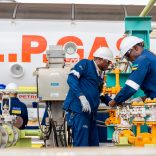Gemfields says illegal miners killed two police guards at Mozambique ruby mine - Reuters
Lower coal prices may be a key strength for Mozambique – By Levy Sergio Mutemba

Courtesy of KPMG / Vale recently inaugurated the Nacala Corridor just as global industrial firms such as Nippon Steel & Sumitomo Metal consider Mozambique as a potential sourcing alternative to Australia.
The inauguration on May 12 of the Nacala Corridor for the transport of coal could not have come at a better time. Though Mozambican coal is considered cheaper than Australia’s, it displays similar quality grades. However, the lack of infrastructure in the South-eastern economy was – and still is – considered as one of the biggest challenge. All the more so that coal prices have not been less volatile than oil in the last couple of years.
The relatively higher logistical costs associated with a lack of railway and port infrastructures often more than neutralise the benefit of a cheaper raw coal than it is the case in a mature market such as Australia or the United States (two of the largest coal producers in the world alongside India, Indonesia and China). Such costs can add around USD 50 to USD 100 per ton to overall production costs.
Being able to offer a low-cost exploration and production opportunities to E&P firms will be key for Mozambique as a growing number of industrial companies who systematically purchase coal for their operations try to diversify their exposure to price volatility. Yesterday, in an interview for Reuters, Japan steelmaker Nippon Steel & Sumitomo Metal insisted on that point. The company is indeed exploring various options aimed at countering their vulnerability to price swings, after it posted a 13% yearly decline in profit for the year ended on March 31 due to higher raw materials costs.
One of the Japanese company’s main sources of coal, Australia, was hit late March by Cyclone Debbie, disrupting rail lines to ports. This urged Nippon Steel & Sumitomo Metal to seek new ways to “secure stable supply” in an environment where coal prices have been “unusually volatile over the last year”, explains Nippon Steel’s executive vice-president Toshiharu Sakae to Reuters. The executive cited Mozambique, alongside United States, Russia and Mongolia, among the countries who offer cheaper coal prices and/or in which one could open new mines.
In this respect, the implementation of the Nacala logistics corridor, signed by the governments of Mozambique and Malawi, Brazil-based mining giant Vale and Japan-based Mitsui, sends a strong signal in terms of the country’s commitment to enhance its infrastructure base. The project consists in the rehabilitation of a 912-km railway connecting the Moatize Coal Mine (in the province of Tete) to Nacala-a-Velha (Nampula), crossing the Malawi Republic.
Estimated at about USD 4.4 billion, the corridor, which will see the development of fleet of nearly 90 locomotives and 1962 wagons, is Vale’s largest investment outside of Brazil. It will enable the firm to increase coal production to up to 18 million tons per year, four times the production level seen in 2016 and almost six times greater than the production in the first full year of operations of the Moatize mine in 2012 (3.7 million tons).
In the meantime, steel and metal producers such as Nippon Steel & Sumitomo Metal must see positively the latest price development in the markets, as the spot price for coal is currently around USD 74 or more than 30% cheaper than during the November peak of USD 110. Yet, the current price is 50% above the one-year low January when it stood at less than USD 50.
Such volatility is mainly stimulated by the ongoing debate over the possibility of an oversupplied market. Last week, Noble Resources indicated that we could see an oversupply of 16 million tons in the coal market this year. It also warned that companies which plan to invest during the second half of the year could face mounting downward pressure on prices. But some producers are less concerned over that issue, convinced that the medium-term prospects are solid, thanks, notably, to the significant economic rebound observed during the last 12 months within the emerging markets after years of subdued growth.
The other bearish risk lies on the Chinese energy policy, as Pekin has recently suspended the building of new coal power plants in almost all its provinces (29 out of 32), a year after having previously cancelled more than 100 new coal power plants. And while China attempts at consuming less coal, coal production in the United States seems on the rise, as production increased 17% there in April.
From a Mozambican standpoint, even if coal prices keep on falling, the country still gains by attracting large global miners (and their investments, of course). The condition is that the costs of extracting the commodity must fall faster or more than the fall of its market price, thanks to more efficient infrastructures such as the Nacala Corridor.
By Levy Sergio Mutemba












Leave a Reply
Be the First to Comment!
You must be logged in to post a comment.
You must be logged in to post a comment.